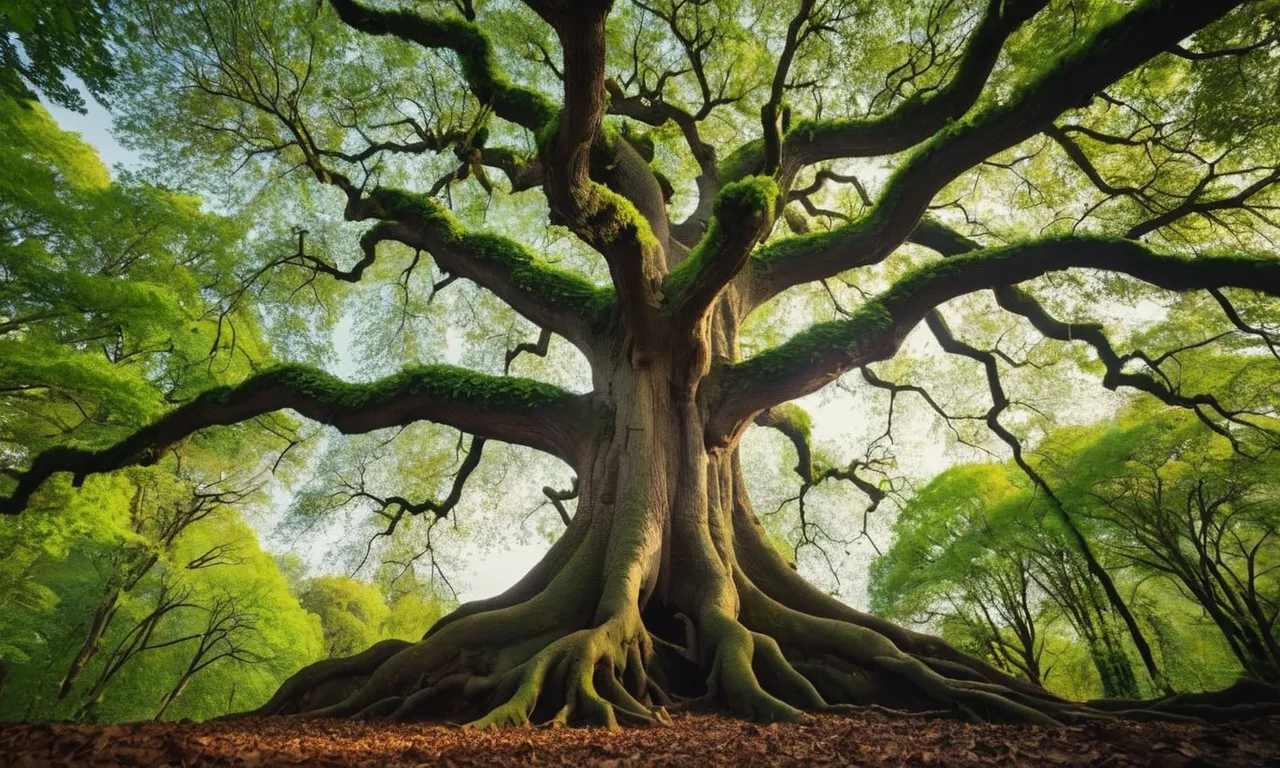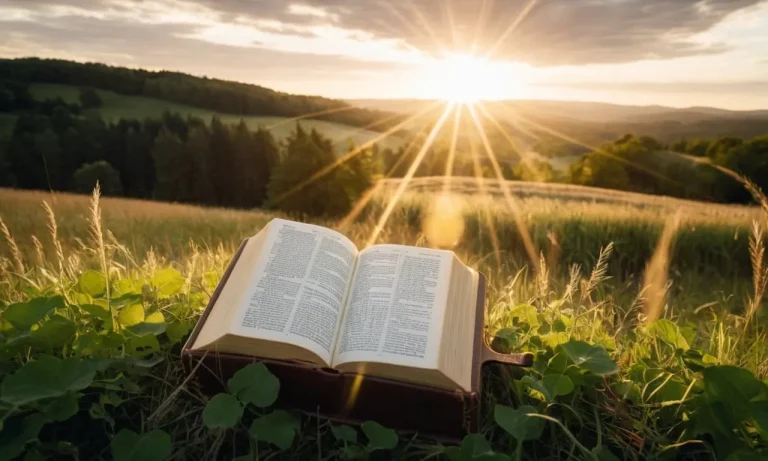The Tree Of Life: Exploring The Profound Symbolism And Meaning
The Tree of Life, a timeless symbol that has captivated the human imagination for centuries, holds a profound and multifaceted meaning that transcends cultures and belief systems.
If you’re short on time, here’s a quick answer to your question: The Tree of Life represents the interconnectedness of all living beings, the cycle of life, growth, and renewal, as well as the spiritual and metaphysical aspects of existence.
In this comprehensive article, we will delve into the rich symbolism of the Tree of Life, exploring its origins, cultural significance, and the various interpretations that have emerged across different traditions and belief systems.
From ancient mythologies to modern spiritual practices, the Tree of Life has served as a powerful metaphor for the journey of life, the interconnectedness of all things, and the quest for enlightenment.
The Origins and Cultural Significance of the Tree of Life
The Tree of Life is a profound symbol that has captivated the human imagination for millennia, transcending cultures and belief systems. Its roots can be traced back to the dawn of civilization, where it was revered as a sacred representation of the interconnectedness of all living beings.
This iconic motif has woven itself into the tapestry of mythology, religion, and indigenous traditions, offering a glimpse into the profound wisdom and spirituality of our ancestors.
Ancient Mesopotamian Mythology
One of the earliest known depictions of the Tree of Life can be found in the ancient Mesopotamian culture, where it was a central symbol in their mythology. The Epic of Gilgamesh, an epic poem dating back to the third millennium BCE, features the Tree of Life as a powerful and sacred entity, guarded by a serpent-like creature.
This tree was believed to possess the power to grant eternal life, a coveted prize in a world where mortality was an inescapable reality.
The Tree of Life in World Religions
- In Christianity, the Tree of Life symbolizes the path to eternal life and the divine wisdom of God. It is prominently featured in the Book of Genesis, where it stands at the center of the Garden of Eden, representing the choice between good and evil.
- In Judaism, the Tree of Life is known as the Etz Chaim, and it symbolizes the interconnectedness of all creation, as well as the Torah, which is seen as the source of spiritual nourishment and wisdom.
- In Islam, the Tree of Life is associated with the Sidrat al-Muntaha, a celestial tree that marks the boundary between the physical and spiritual realms. It is believed to be the destination of the Prophet Muhammad’s miraculous journey, where he received divine revelations.
Indigenous Cultures and the Tree of Life
The Tree of Life holds a sacred place in many indigenous cultures around the world. For example, in the Native American traditions, the Tree of Life represents the interconnectedness of all living beings, with its roots reaching deep into the earth and its branches stretching towards the heavens.
It is a symbol of balance, harmony, and the cyclical nature of life. In the Mayan culture, the Ceiba tree was revered as the Tree of Life, believed to connect the underworld, the earth, and the celestial realms.
Across cultures and belief systems, the Tree of Life stands as a powerful reminder of our deep connection to the natural world and the profound mysteries that lie at the heart of existence. Its enduring symbolism continues to inspire awe and reverence, inviting us to explore the depths of our spiritual and cultural heritage.
With its branches reaching towards the heavens and its roots anchored in the earth, the Tree of Life reminds us of the delicate balance and interconnectedness of all life, a lesson that is as relevant today as it was in ancient times.
The Tree of Life as a Symbol of Interconnectedness
The Tree of Life, an ancient and enduring symbol found in numerous cultures and belief systems, serves as a powerful metaphor for the intricate web of life that binds all beings together. This iconic representation transcends mere aesthetics, delving deep into the profound interconnectedness that permeates our existence.
It reminds us that we are all part of a vast, intricate tapestry, woven together by the threads of life itself.
The Web of Life
Just as the branches of a tree extend outward, intertwining and supporting one another, the Tree of Life symbolizes the intricate connections that exist between all living beings. From the tiniest microorganisms to the mightiest of creatures, we are all part of a delicate ecosystem, each playing a crucial role in the grand scheme of things.
According to a study by the University of British Columbia, over 80% of all terrestrial species are interconnected through complex food webs and symbiotic relationships, highlighting the intrinsic interdependence that sustains life on our planet.
The Cycle of Birth, Growth, and Renewal
The Tree of Life also represents the cyclical nature of existence, symbolizing the continuous cycle of birth, growth, and renewal. Just as a tree sheds its leaves in the autumn, only to sprout new ones in the spring, life itself is a constant dance of transformation and regeneration.
This cycle is evident not only in the natural world but also in our own lives, as we navigate through various stages of growth and change. The Britannica Encyclopedia notes that understanding life cycles is crucial for understanding the dynamics of populations and ecosystems, further emphasizing the interconnected nature of all living beings.
The Interconnectedness of All Beings
At the heart of the Tree of Life’s symbolism lies the profound truth that we are all interconnected, bound by an invisible web of energy and consciousness. Just as the roots of a tree draw nourishment from the soil, and its branches reach towards the sun, we too are sustained by the very elements that make up our world.
The United Nations recognizes the importance of biodiversity and its role in sustaining life on Earth, highlighting the intricate connections between all living beings. This interconnectedness extends beyond the physical realm, encompassing the spiritual and emotional aspects of our existence as well.
The Tree of Life serves as a poignant reminder that we are all part of a greater whole, a vast and intricate tapestry of life that transcends boundaries and embraces diversity. By embracing this symbol and the profound truths it represents, we can cultivate a deeper appreciation for the interconnectedness of all beings and strive to live in harmony with the world around us.
😊🌳
The Spiritual and Metaphysical Aspects of the Tree of Life
The Tree of Life is a profound and multifaceted symbol that has captivated the minds of mystics, philosophers, and seekers of wisdom for centuries. At its core, it represents the interconnectedness of all things, the journey of self-discovery, and the universal principles that govern the cosmos.
In this section, we delve into the spiritual and metaphysical aspects of this ancient symbol, exploring its significance in various esoteric traditions and its potential for personal growth.
The Tree of Life and the Kabbalah
One of the most prominent associations of the Tree of Life is with the Kabbalah, the ancient Jewish mystical tradition. In the Kabbalistic teachings, the Tree of Life is a symbolic representation of the divine emanations, known as the Sephiroth, which are believed to be the channels through which the infinite divine energy flows into the physical realm.
This intricate symbol is often depicted as a diagram with ten spheres connected by twenty-two pathways, each representing different aspects of the divine and the cosmos. According to Kabbalah.info, the Tree of Life serves as a roadmap for spiritual growth and understanding the nature of reality.
The Tree of Life in Esoteric Traditions
Beyond the Kabbalah, the Tree of Life holds significant meaning in various esoteric traditions around the world. In the Hermetic and Gnostic teachings, the Tree of Life symbolizes the interconnectedness of the material and spiritual realms, as well as the journey of the soul through different levels of existence.
In some Eastern philosophies, such as Hinduism and Buddhism, the Tree of Life represents the cosmic order and the interconnectedness of all beings. 😊
According to Ancient.eu, the Tree of Life appears in various ancient cultures, including Mesopotamian, Egyptian, and Norse mythologies, often symbolizing the cosmic axis connecting the realms of the divine, the earthly, and the underworld.
Its universal symbolism transcends cultural boundaries, resonating with the human experience of seeking meaning and understanding one’s place in the grand tapestry of existence.
The Tree of Life and Personal Growth
Beyond its spiritual and metaphysical significance, the Tree of Life can also serve as a powerful tool for personal growth and self-exploration. Each sphere and pathway on the Tree represents different aspects of the human experience, such as wisdom, strength, beauty, and compassion.
By studying and contemplating the Tree of Life, individuals can gain insights into their own inner landscape, identifying areas for growth and personal development.
Many practitioners of various esoteric traditions utilize the Tree of Life as a framework for meditation, visualization, and self-reflection. By aligning themselves with the energies and principles represented by the different spheres and pathways, they can cultivate greater self-awareness, emotional balance, and spiritual understanding.
👏 According to Psychology Today, the Tree of Life can serve as a powerful metaphor for personal growth, helping individuals navigate the complexities of life’s journey and find greater meaning and fulfillment.
In essence, the Tree of Life is a timeless symbol that reminds us of our interconnectedness with the cosmos and the profound depths of human potential. Whether explored through the lens of ancient mystical traditions or modern personal growth practices, this ancient symbol continues to inspire and guide those seeking a deeper understanding of themselves and the universe around them.
🎉
The Tree of Life in Art and Literature
The Tree of Life, a symbol that transcends cultures and religions, has been a recurring motif in art and literature throughout history. Its profound symbolism and meaning have captivated artists, writers, and poets, who have interpreted and represented it in various forms, each imbued with their unique perspectives and creativity.
The Tree of Life in Visual Arts
In the visual arts, the Tree of Life has been depicted in a myriad of ways, from intricate carvings and sculptures to vibrant paintings and illustrations. One of the most famous representations is the Tree of Life relief panel at the Assyrian capital of Nimrud, dating back to the 9th century BCE.
This ancient artwork portrays the tree as a symbol of fertility, abundance, and the interconnectedness of all living beings. In modern times, artists like Gustav Klimt and Frida Kahlo have incorporated the Tree of Life into their masterpieces, imbuing it with their personal interpretations and cultural influences.
The Tree of Life in Literature and Poetry
The Tree of Life has also found its way into the realms of literature and poetry, where writers and poets have explored its symbolism and meaning through their words. From ancient texts like the Bible’s Book of Genesis to contemporary novels, the Tree of Life has been a recurring motif, representing concepts such as knowledge, immortality, and the interconnectedness of all life.
Poets like William Butler Yeats and Robert Frost have woven the Tree of Life into their verses, imbuing it with layers of metaphor and symbolism that resonate with readers across generations.
The Tree of Life in Modern Popular Culture
In recent decades, the Tree of Life has transcended its traditional artistic and literary realms and has found its way into modern popular culture. From the iconic film “The Tree of Life” by Terrence Malick, which explores existential themes through the lens of a family’s experiences, to the intricate Tree of Life sculpture at the Expo 2020 Dubai, this symbol continues to captivate and inspire.
Moreover, the Tree of Life has become a popular motif in various forms of art, from jewelry and home decor to tattoos and fashion designs, reflecting its enduring appeal and relevance in contemporary society.
Whether depicted through visual arts, literature, or modern popular culture, the Tree of Life remains a powerful and enduring symbol that transcends time and cultures. Its profound symbolism and meaning continue to inspire artists, writers, and creators, who interpret and represent it in ever-evolving forms, ensuring that this ancient motif remains relevant and resonant for generations to come.
The Tree of Life as a Symbol of Hope and Resilience
The tree of life, an ancient and ubiquitous symbol found in cultures across the globe, has long been revered for its profound meaning and symbolism. This iconic representation of the interconnectedness of all living beings resonates deeply with our collective consciousness, serving as a powerful reminder of our intrinsic connection to nature and the cyclical nature of existence.
The Tree of Life and Environmental Consciousness
As the world grapples with the pressing issue of climate change and environmental degradation, the tree of life has emerged as a rallying symbol for environmental consciousness and sustainability efforts.
Organizations like The Tree of Life Resources Institute are dedicated to promoting ecological awareness and sustainable practices, drawing inspiration from the tree of life’s representation of the delicate balance that exists within nature.
According to a recent study by the World Wildlife Fund, over 60% of the world’s wildlife populations have been decimated since 1970, underscoring the urgent need for environmental action.
The Tree of Life and Personal Resilience
Beyond its environmental symbolism, the tree of life also serves as a powerful metaphor for personal resilience and growth. Just as a tree weathers storms, endures droughts, and adapts to changing conditions, so too must we navigate the challenges and adversities that life presents.
The tree’s ability to bend without breaking and its capacity for renewal and regeneration inspire us to cultivate a similar resilience within ourselves. As the renowned psychologist Jon Kabat-Zinn eloquently states, “Like a tree, we too can grow in wisdom and resilience, and remain firmly rooted in the ground of our own being.”
The Tree of Life and Community Building
The tree of life also serves as a potent symbol of community building and interconnectedness. Its branches, extending outward and intertwining with one another, represent the intricate web of relationships that bind us together as a society.
Just as the roots of a tree draw nourishment from the earth, our communities thrive when we nurture and support one another. Organizations like The Tree of Life Solidarity are dedicated to fostering community resilience and promoting social justice, drawing inspiration from the tree of life’s symbolism of unity and collective strength.
In a world that often feels fragmented and disconnected, the tree of life stands as a powerful reminder of our shared humanity and our inextricable connection to the natural world. Whether we seek inspiration for environmental stewardship, personal growth, or community building, this ancient symbol continues to resonate, offering hope, resilience, and a sense of belonging to all who embrace its timeless wisdom.
😊
Conclusion
The Tree of Life, a symbol that has transcended time and cultures, continues to captivate and inspire individuals across the globe. Its profound meaning and multifaceted interpretations offer a rich tapestry of wisdom, reminding us of the interconnectedness of all life, the cyclical nature of existence, and the spiritual and metaphysical aspects that bind us together.
Whether viewed through the lens of ancient mythologies, world religions, indigenous cultures, or modern spiritual practices, the Tree of Life stands as a powerful metaphor for growth, renewal, and the interconnectedness of all beings.
Its symbolism has permeated art, literature, and popular culture, serving as a source of inspiration and a reminder of our shared humanity.
As we navigate the complexities of our modern world, the Tree of Life invites us to embrace a deeper understanding of our place within the intricate web of life, to cultivate a sense of reverence for the natural world, and to nurture our personal and collective growth.
By embracing the profound wisdom embodied in this timeless symbol, we can find solace, hope, and resilience in the face of life’s challenges, and ultimately, contribute to the creation of a more harmonious and interconnected world.








